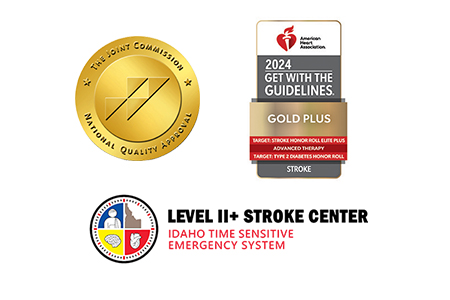Stroke Center in Idaho Falls, Idaho
Health Risk Assessments
Take one of our free health risk assessments! This short quiz helps highlight your risk factors for certain diseases or conditions and provides personalized recommendations.
Eastern Idaho Regional Medical Center (EIRMC) is a Primary Stroke Center certified by The Joint Commission. This means if you or a loved one experiences a stroke, our facility provides the most advanced stroke treatment available in the area.
If you or someone you know is having a stroke, call 911 immediately.
Nationally recognized stroke treatment
At EIRMC, we deliver an aggressive approach to stroke with expertise from a multidisciplinary team of specialists in neurological care. Both patient and family participate in family planning, and each program is designed to ensure all necessary support services are provided.
When you get to a hospital quickly, a computerized tomography scan is performed to determine the type of stroke. Depending on your recent medical history, and if you arrive within three hours of symptom onset, the clot-busting medication tPA (tissue plasminogen activator) can be administered intravenously to begin dissolving the clot.
Within 24 hours of symptoms, neurologists and interventional radiologists may decide to intervene further with one or multiple of the following procedures by inserting a catheter through the groin into the artery, all the way up to the brain. The catheter gives access to a number of devices for various procedures, including thrombectomy.
 The Joint Commission awards hospitals with advanced certification based on a rigorous examination process to identify facilities demonstrating a commitment to excellence in stroke care. Some of the protocols include:
The Joint Commission awards hospitals with advanced certification based on a rigorous examination process to identify facilities demonstrating a commitment to excellence in stroke care. Some of the protocols include:
- Consistent use of IV tPA therapy (clot-busting medication)
- 24/7 availability of a neurologist or interventional radiologist
- Evidence-based clinical practice guidelines
- Designated stroke team
- Coordinated stroke response with area emergency crews
Stroke data is analyzed and reported regularly to achieve continuous improvement, exceed standards of care, improve patient outcomes, and maintain certification.
Additionally, we're proud to be designated as a Stroke Level II+ Center by Idaho Time Sensitive Emerency Council. EIRMC has also been recognized five years in a row by the American Heart Association and American Stroke Association with the Stroke Gold Plus award for excellence in implementing the Get With The Guidelines® program.
Learn more about our stroke outcome measurements.
What is a stroke?
A stroke occurs when a blood vessel carrying oxygen to the brain becomes blocked or ruptures. When this happens, part of the brain no longer receives the oxygen it needs, and the tissue in that area starts to die.
At EIRMC, we take an aggressive, multidisciplinary approach to stroke treatment with expertise from neurologists, registered nurses, dietitians, interventional radiologists and other stroke care specialists.
Types of stroke we treat
At a Primary Stroke Center, we can quickly diagnose the difference between the two types of stroke: ischemic and hemorrhagic. The vast majority of strokes are ischemic. An ischemic stroke occurs when a clot blocks blood flow in the brain. A hemorrhagic stroke is caused by bleeding interfering with the brain's ability to function. This bleeding can happen within the brain or in the area between the brain and the skull.
Transient ischemic attacks, commonly referred to as TIAs, are stroke symptoms that go away shortly after starting due to momentary blockages but produce no lasting damage. Even if your symptoms disappear entirely, it is critical to follow up with a neurologist to assess your continued risk of stroke.
Signs and symptoms of stroke
Part of our goal is to educate you on the signs, symptoms and risk of stroke. To recognize the warning signs of stroke, remember to BE FAST:
- B — Balance: Ask the person if they can walk. Do they veer to one side? Are they dizzy?
- E — Eyes: Cover one eye at a time and ask if they have vision changes.
- F — Face: Ask the person to smile. See if one side of the mouth droops.
- A — Arms: Ask the person to lift both arms. See if one uncontrollably lowers.
- S — Speech: Ask the person to repeat simple phrases to see if there is difficulty or confusion.
- T — Time: If a person exhibits any of these symptoms, time is of the essence. Call 911 immediately and tell the dispatcher you think it may be a stroke.
Additionally, warning signs of stroke include:
- Sudden numbness or weakness of the face, arm or leg, especially on one side of the body
- Sudden confusion, trouble speaking or understanding others
- Sudden trouble seeing in one or both eyes
- Sudden dizziness, loss of coordination or balance or trouble walking
- Sudden severe headache with no obvious cause
Stroke rehabilitation
Our goal for stroke rehabilitation is the same as yours: to maximize recovery so you can return to the fullest level of independence possible. Our rehabilitation therapy team includes specialists in:
- Physical therapy
- Speech therapy
- Occupational therapy
- Respiratory therapy
Stroke risk factors
The vast majority of strokes occur in people 60 years old and older, but risk factors can make people as young as 40 years old highly susceptible as well. Women have a slightly higher risk than men due to contraceptive use. Other risk factors for stroke include:
- High blood pressure
- Diabetes
- Heart disease
- High cholesterol
- Lack of exercise
- Smoking